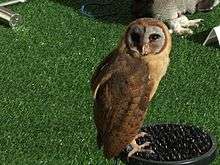Ashy-faced owl
| Ashy-faced owl | |
|---|---|
 | |
| Ashy-faced owl | |
| Scientific classification | |
| Kingdom: | Animalia |
| Phylum: | Chordata |
| Class: | Aves |
| Order: | Strigiformes |
| Family: | Tytonidae |
| Genus: | Tyto |
| Species: | T. glaucops |
| Binomial name | |
| Tyto glaucops (Kaup, 1852) | |
The ashy-faced owl (Tyto glaucops) is a species of owl in the family Tytonidae. It is found in Haiti and the Dominican Republic. Its natural habitats are subtropical or tropical dry shrubland, subtropical or tropical high-altitude shrubland, and, now, heavily degraded former forest.
Description
The ashy-faced owl is quite similar to darker types of barn owl. The facial disc is heart-shaped and ashy grey. The dorsal (upper) surface of the head and body is yellowish-brown speckled with dark grey or black and the ventral (under) surface is pale. Adults grow to a length of 26 to 43 centimetres (10 to 17 in) and weigh between 200 and 400 grams (7.1 and 14.1 oz). The call is a rapid series of clicks followed by a wheeze, and the bird can also emit a shrill scream.[2]
Distribution
The ashy-faced owl is endemic to Hispaniola and some of the smaller islands in its vicinity.[1] Its typical habitat is forest and open woodland and it is often found near towns and villages.[2]
Behavior
The ashy-faced owl is a resident species and does not migrate. It nests in holes in trees, in crevices in rocks, on rocky ledges and inside buildings. A clutch of between three and seven eggs is laid some time between January and July.[2]
Like most other owls, the ashy-faced owl is nocturnal and feeds on small vertebrates. The barn owl (Tyto alba) was introduced into Hispaniola in about 1950. A study, published in 2010, was undertaken in the Dominican Republic to determine the diets of both owls and whether they compete with each other for food. This was done by examining the regurgitated pellets the owls produce which contain the undigested bones, fur and feathers of their prey. It was found that they each consume over one hundred species of prey with ninety two species being in common between the two.[3] Small mammals predominated in both diets, particularly so in the barn owl, and made up the greatest proportion of the biomass. Both caught a similar proportion of bats but the ashy-faced owl caught more birds. Amphibians and reptiles were also consumed more often by the ashy-faced owl than by the barn owl. No conclusion could be reached as to whether the competition for food which was caused by the arrival of the barn owl was detrimental to the native species.[3]
Status
The IUCN lists the ashy-faced owl in its Red List of Threatened Species as being of "Least Concern". This is because it has a very wide range and, although the bird is not common, its population appears to be stable.[1] The ashy-faced owl faces competition for nesting sites and suitable habitat from the stronger American barn owl (Tyto alba pratincola).[2]
References
- 1 2 3 BirdLife International (2012). "Tyto glaucops". IUCN Red List of Threatened Species. Version 2013.2. International Union for Conservation of Nature. Retrieved 26 November 2013.
- 1 2 3 4 "Ashy-faced Owl: Tyto glaucops". World Owl Trust. 2005-02-01. Retrieved 2013-10-07.
- 1 2 Wiley, James W. (2010). "Food Habits of the Endemic Ashy-Faced Owl (Tyto glaucops) and Recently Arrived Barn Owl (T. alba) in Hispaniola". Journal of Raptor Research. 44 (2): 87–100. doi:10.3356/JRR-08-100.1.
